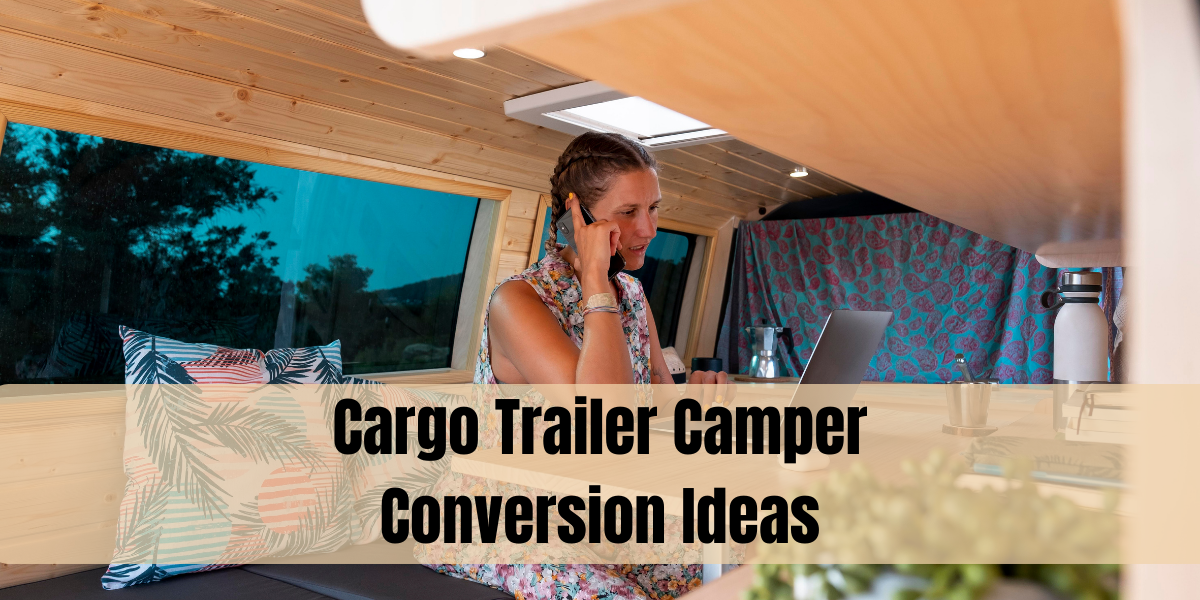Are you thinking of transforming your trailer? It happens rather frequently these days, so it is possible. Finding a used cargo trailer and converting it into an RV are two of the most well-liked DIY methods for building an RV.
How to Pick the Travel Trailer for a Camper Conversion
Choosing the appropriate trailer for the transformation is key.
A New or Used Trailer
When it comes to building a platform with little wear and tear, a new trailer tends to be the best choice. The tires are fresh with good tread, the suspension mechanism has yet to be abused, and there are usually no rust concerns to be concerned about. A new cargo trailer, on the other hand, will be more expensive to purchase and insure.
If the old trailer has been paid for, you can obtain it via a private buyer for a modest price. You only need to ensure that the structure is strong and rust-free. You should also inspect, if not update, the suspension components and tires to alleviate issues regarding how wear and tear would affect your budding camper design.
Check the Bearings and the Tires
If you choose an older cargo trailer or covered equipment trailer, chances are the tires have a lot of miles on them. Think about switching to new tires if the cost is within your budget. Then go the extra mile and invest in a high-quality spare. That way, you won’t be stranded if something goes wrong.
Bearings are another item that might go unseen aboard a cargo trailer until they break and cause significant damage. If you plan to convert a cargo trailer to a used freight trailer longer than 5 to 7 years old, you must change or repack the bearings.
Replacement tires cost between $100 and $200, and replacing the bearings costs from $100 to $400.
System of Suspension
If at all feasible, consider updating the suspension system. It would be considered throughout the planning phases of your camper conversion because you can be confident that the suspension components on a new cargo trailer can handle the weight rating. If you choose a used cargo trailer or equipment trailer, you should expect it to support around 80% of what is rated in the standards.
When you know the maximum weight your cargo trailer can handle, you can compare it to the capacity of the amenities and appliances you intend to add. You should aim for an upper weight restriction of the recommended specs.
Replacing the suspension system can range between $500 to $2,500.
Which Kind of Trailer Camper Would Be A Converted Cargo?
There are several styles to choose from, which may make the purchasing experience a bit daunting.
V-Nose
It is an enclosed trailer with a V-shaped front, which is the opposite of a flat front. It extends just a little to the front, which might be used for extra shelves and storage space. Some individuals utilize this extra room to have a toilet and shower.
Furthermore, the design of these safe trailers allows for greater fuel savings. The aerodynamic form improves economy per liter and saves money on gasoline when on a road trip.
Flat Nose
The most common and least expensive choice is a basic box-shaped trailer. The box form provides additional space near the hitch. Furthermore, its modular structure simplifies interior design.
Wind resistance is an essential consideration for flat-nose trailers. If you’re concerned that your cargo camper may slow you down, try installing a wind deflector on the roof. You may produce an aerodynamic effect for a little cost. Such tiny expenditures enable you to save significantly in the long run, particularly the gasoline expenses.
Toy Hauler
They are classified as RVs because they include fold-down ramps and specialized garage sections for heavy objects such as bikes and boats. The built-in garage is perfect for many campers and is an excellent choice for a camper conversion. A bumper pull is the most popular type of toy transporter, and it has roughly the same load capacity as a commercial trailer of the same dimensions.
The Ideal Cargo Trailer Size
Before searching for a trailer, you need to determine your vehicle’s towing capability. For example, if you’ll want to employ it as a temporary residence for yourself.
Cargo Trailer 5′ x 8′
This size is appropriate when you are a solitary camper or want to go separately in a different vehicle. It’s tiny enough to fit a single bed, a tiny kitchen, and a basic cabinet for accessories. Such cargo vehicles typically weigh roughly 800 pounds and can easily transport 2,200 pounds of load.
Cargo Trailer 6′ x 10′
It is an excellent choice for two people or a single camper driving with a dog. The cargo trailers will include comfy beds, more space for a larger shelf or cabinet, and a kitchen. The trailer weighs roughly 1,000 pounds and has a capacity of 1,800 pounds.
Cargo Trailer 6′ x 12′
They are suitable for two people who enjoy camping regularly. It will include two beds, a separate shower room, a bigger closet, a sink, and a fully equipped kitchen. The trailer weighs around 1,200 pounds and has a carrying capacity of approximately 1,800.
Cargo Trailer 7′ x 12′
These trailers are ideal for couples who frequently embark on longer camping holidays or road journeys. Furthermore, you can bring a young child or a pet with you.
The trailer can accommodate a normal bed and a more expansive room with a huge shower, kitchen, sink, and various shelves. It is large, weighing 1300 pounds. It can easily support 1700 pounds of weight.
Cargo Trailer 7′ x 14′
You should consider this alternative if you have a small family and a huge truck. Similarly, if you use the space well, you may add a pair of bunk beds or a bigger bed with multiple shelves. You may even install a more practical kitchen or even a modest refrigerator. The trailer weighs roughly 1,400 pounds and has a capacity of 1,600 pounds.
Cargo Trailer 7′ x 16′
It is excellent for the whole family or a group of colleagues looking to unwind. You may include several sleeping arrangements, a place to relax, a functioning kitchen with a fridge, a display space, and numerous shelves to keep your belongings. The trailer weighs around 1,200 pounds and has a carrying capacity of approximately 1,800.
Features and Appliance Selections
Determine how much load it can fairly support, and now you must decide everything you’d like to put inside it. To assist you in designing the cargo trailer conversion camper, consider the following possibilities.
Electricity System
It will be one of the more expensive solutions, and you will also require other key components, like an inverter. Although, the components may be purchased and installed on your own.
12 Volt Batteries
Another possibility is powering your system using a 12-volt, long-cycle battery bank. They will use DC electricity to power the lighting and more basic electronics. If you want to purchase DC home batteries, consider purchasing a battery monitor—one RV 12 Volt long cycle battery costs between $125 and $250.
Solar Panels Or Wind Generator
Solar panels and wind turbines marketed at retail are significantly more efficient today. You need to utilize 12 Volt long-cycle batteries to keep the charge they create. It might be an excellent alternative for keeping your home batteries charged above 50%. A 100 Watts solar panel costs between $75 and $160.
Generator
On occasions when you wish to camp off the grid, generators are an excellent source of electricity. There are some AC outlets on a tiny 2,000 Watt generator to plug in necessary items or power several lights. The 2,000 Watt 4-stroke motor can cost anywhere between $450 and $1,500.
Conditional Air
Installing an in-wall air conditioner immediately into the sides or front cap of the cargo trailer is one of the simplest methods for sleeping cool and comfortably. The hatch cover may be installed, allowing you to travel with the hold sealed. When it’s time to camp, open the sealed hatch and connect your air conditioner to the nearest power source. The cost goes from $250 to $450.
Sleeping Facilities
You should consider the height of the person and the number of people you will be sharing a bed with.
Murphy Beds
They slide out of the wall using sturdy piano-style hinges as soon as you want to sleep. It’s a fantastic method to conserve space on the floor.
Couch Bed
It’s an excellent way to travel with a storage room, a comfy seat during the day, and a comfortable bed at night.
Kitchen
Many conversion campers place a high focus on having a useful kitchen. We need to consider the weight and size of the following kitchen accessories:
The Range Top
Generally, you can accomplish this by reusing a gas camp stove. Some even include mounting hardware-compatible holes in the base. The price might be between $50 and $350.
The Oven
For installation in your camper that has been converted, you can purchase an independent stove or an RV oven and cooktop combo. The price might be between $250 and $750.
The Sink
It’s great to wash your hands and your dishes. However, adding a sink increases the weight and plumbing requirements. The next step is to install a small gray water storage container underneath the sink. Make sure your design has adequate room for the drain’s gooseneck. A camper sink with fittings might cost between $15 and $50.
The Hot Water Heater
You may connect the water heater to your gas tanks to get a little supply of hot water. It could cost from $550 to $1,000.
Bathroom
Plenty of plumbing and water storage tanks will be needed to put in a working toilet or wet bath. All of those will increase the load.
Outdoor Shower
This may be as easy as hanging a solar shower on a neighboring tree. The water is warmed by the sun-heated black plastic.
A privacy tent will resemble a bathroom. You could alternatively place it close to the camper and connect a line to a tank-style or tankless water heater to power a shower head. A solar shower and privacy tent may cost between $25 and $100.
The Toilet
Many portable composting restrooms are made with the environment in mind. A tiny porta toilet may cost between $85 and $200.
FAQs
Are Camper Conversions on Cargo Trailers Worth It?
Everything depends on how soon you want to start driving and if you have the patience for an entertaining DIY venture and desire a camper that should last for a long time. Of course, it’s worth it!
How Do You Create Floor Plans for a Camper Conversion?
It’s possible to obtain preset designs online, which may be especially useful if you’re not very creative with a ruler or if you’ve already discovered an interior footprint configuration you like. Although many effective cargo trailer camper conversions design custom floor plans from the start, acquiring premade blueprints offline is also feasible.
There are cargo trailer sizes available, including 7×12, 8×16, and 6×14. You should be sure your plans won’t result in a math mistake if the trailer you’re using is a different size.
What Is the Cost of the Conversion?
Due to each cargo trailer’s distinctive design and construction, prices will differ from camper to camper. The total cost of the construction was roughly $13K. That sum covers the cost of the trailer and all of the construction supplies.
Wrap-Up
None of the amenities that make an RV cozy and pleasant are pre-installed in cargo vans. That’s only one of the reasons why this is gaining so much traction among campers. By making your covered trailer conversion, you get a unique vehicle and far less expensive than anything you’d find on a typical lot.





